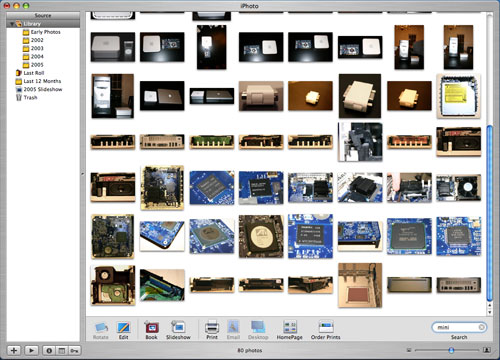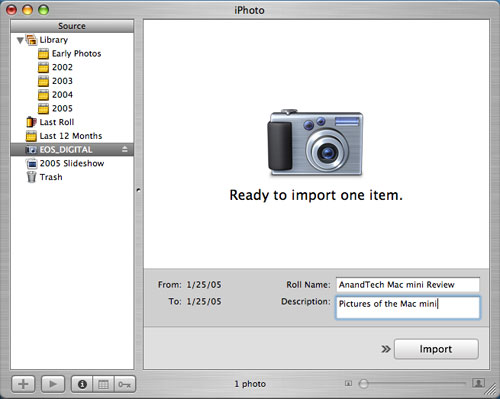Apple's Mac mini - Tempting PC Users Everywhere
by Anand Lal Shimpi on January 25, 2005 7:39 AM EST- Posted in
- Mac
iPhoto 5
For the most part, I detest photo management applications. They are usually riddled with cumbersome interfaces and/or lack any sort of real editing power. I tried using iPhoto 4, which was a part of the iLife '04 suite, and I was left fairly disappointed. I had to switch between editing and organizing modes to edit or just flip through my pictures. Images took entirely too long to flip through and despite the fact that iPhoto had the best interface of any photo management application that I'd used, it was still not enough. In the end, it was just like everything else to me and I happily continued using Photoshop for editing and saving pictures for AnandTech articles. I used folders to organize the pictures according to article, so I didn't need the organizational aspects of iPhoto for that. But then came iPhoto 5 - time to give it another try, but this time, it looked like there was hope.
During his keynote at Mac World San Franciso, Steve Jobs talked about iPhoto 5 as the only application that you'd need for both editing and organizing your photos. For my uses, Photoshop is basically overkill, but I've never found anything to suit my needs better without sacrificing usability in one way or another. But with a better interface and a new editing dashboard, iPhoto 5 seemed promising.

The iPhoto 5 interface has been greatly simplified. No longer are there different modes to switch between, everything happens in the same browsing mode. You get photos into iPhoto using its import feature, which is activated automatically whenever you connect a digital camera or a removable disk (a configurable option).
Thankfully, iPhoto gives you the option of deleting your photos automatically from the media/camera after it is done importing them. Once you confirm your intentions, iPhoto goes off and copies all of the photos into your iPhoto Library. Your photo library can be viewed at variable sized thumbnails, adjustable by a slider in the lower right of the application. The scaling of the number of pictures on your screen at one time happens very quickly as iPhoto will render the thumbnails quickly, and then later, sharpen the images once you're done playing with the slider. iPhoto is much faster (especially on the G5) now, and photos no longer take a little bit of time to come into focus when browsing through them one at a time (as opposed to a page of thumbnails). Also, when browsing quickly, they will appear as thumbnails rather than blurry images (more useful in my opinion).
The iPhoto Library is organized by year and feeds off of the information written by your camera to the images. If you have a lot of photos, the Library quickly becomes cluttered, since it is organized by nothing more than date. This is where some of the indexing features of iPhoto come into play, but they do require a bit of user intervention.

When you import images into the Library, you have the option of tagging the images that you import with a title. For example, when I imported the images for this review, I titled them "Mac mini". Now, even if I have thousands of images taken in 2005, I just type in "mini" in the search box and all my Mac mini images come up instantly, thanks to a fully indexed search in iPhoto. Now, titling images isn't something that I'd normally take the time to do, but the way iPhoto works is that you just create one general title and it will apply it to all of the photos that you're importing (or you can selectively import them).

After they are imported, you can go back and add ratings, keywords and comments to photos on an individual basis, all of which are fully searchable fields. You also have the option of populating these fields after the fact using iPhoto's batch processing. Just highlight what photos you want and you can add a title, comments or even modify the date/time. And if you actually take the time to make good use of these searchable fields, or even if you just make use of the batch titling upon import, you can create Smart Albums based on searches of these fields. For example, you can create an album of all pictures of "video cards" or "cars I'd like to buy" or just about any other combination that you can think of.
Personally, I'm not enough of a photo enthusiast to put that much time into my digital library, but if you have a habit of taking a lot of pictures, iPhoto 5 offers some very excellent and intuitive ways of organizing them. Plus, the interface works and feels just like the rest of OS X, which is a very strong point of iPhoto. There is one exception to my last statement, however. Hitting Command + W will actually exit the iPhoto program itself, something which breaks the way that almost all OS X applications work. One thing that I was a fan of with OS X is the consistency with which all applications behaved, and iPhoto unfortunately breaks that consistency - not something I was too happy with.










198 Comments
View All Comments
karlreading - Tuesday, January 25, 2005 - link
#23:You kick up against mac bashers and then u have a pop at AMD fans. HOW RUDE. It's quiet obvisouse your a intel fan. your no better than the people you try to show up, claiming they do things whilst you do exactly the same things yourself.
Im a AMD fan, but i dont find that i have to have a pop at intel, mac, or anyone else. AMD make fine products. Intel make fines products. Apple make fine products. just each ones products match diffrent peoples expectations and needs.
as for the mac mini, i think its a excellent little machine. As Anand says, more appliance than computer. i think they will do well.
karlos
Dranzerk - Tuesday, January 25, 2005 - link
#2 in response to #1 Im talking about how lots of people will buy these because it's the "it" thing to do, and I will be looking on Ebay for when they are sold cheaper.How was that hard to understand?
michael2k - Tuesday, January 25, 2005 - link
Well, if it's within the return period, you can technically 'return it' and get another, with the Tiger CDs/DVDs, or just tell the Apple person, "It would be better for you to send me the Tiger CDs, wouldn't it, than to return this one to CompUSA and get a new one with the new OS right?"So within two weeks I would expect it free, basically (though it takes some social engineering). I don't know about the 'heavy discount' however.
bupkus - Tuesday, January 25, 2005 - link
Perhaps Apple should have offered the mini with 512MB as standard and then offered a downgrade option rather than their upgrade option.bob661 - Tuesday, January 25, 2005 - link
If you want Tiger, just wait till it's released then by the Mac.msva124 - Tuesday, January 25, 2005 - link
You say if tiger comes out right after you buy your machine, it is heavily discounted. Define "right after".Draco - Tuesday, January 25, 2005 - link
Great article. Very refreshing to see so much Mac coverage. Look forward to more.Ecgtheow - Tuesday, January 25, 2005 - link
#59: If Tiger comes out right after you get your machine, you can get it for $30 through the "Up-to-date" program.sluramod - Tuesday, January 25, 2005 - link
#57: good news for apple then ... $499 now + $100 or so laterBurbot - Tuesday, January 25, 2005 - link
#40: Thanks for correction.#53: Very true. A lot of people do not understand the connection between memory amount and performance. I've seen that more then once - folks have a machine with 128 megs of RAM that is just dying under load, and when I suggest them a memory upgrade they say "But isn't Ghz the thing that makes it go faster?".